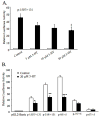Transcriptional regulation of the human Na+/H+ exchanger NHE3 by serotonin in intestinal epithelial cells
- PMID: 19303862
- PMCID: PMC2676776
- DOI: 10.1016/j.bbrc.2009.03.087
Transcriptional regulation of the human Na+/H+ exchanger NHE3 by serotonin in intestinal epithelial cells
Abstract
Serotonin (5-HT) decreases NHE2 and NHE3 activities under acute conditions in human intestinal epithelial cells. Here, we have investigated the effects of 5-HT on expression of the human NHE3 gene and the mechanisms underlying its transcriptional regulation in differentiated C2BBe1 cells. Treatment of the human intestinal epithelial cell line, C2BBe1, with 5-HT (20 microM) resulted in a significant decrease in NHE3 mRNA and protein expression. In transient transfection studies, 5-HT repressed the NHE3 promoter activity by approximately 55%. The repression of the NHE3 promoter activity in response to 5-HT was accompanied by reduced DNA-binding activity of transcription factors Sp1 and Sp3 to the NHE3 promoter without alteration in their nuclear levels. Pharmacological inhibitors of protein kinase C reversed the inhibitory effect of 5-HT on the promoter activity. Our data indicate that 5-HT suppresses the transcriptional activity of the NHE3 promoter and this effect may be mediated by PKCalpha and modulation of DNA-binding affinities of Sp1 and Sp3.
Figures




References
-
- Kohle C, Badary OA, Nill K, Bock-Hennig BS, Bock KW. Serotonin glucuronidation by Ah receptor- and oxidative stress-inducible human UDP-glucuronosyltransferase (UGT) 1A6 in Caco-2 cells. Biochem Pharmacol. 2005;69:1397–1402. - PubMed
-
- Kawano H, Tsuji H, Nishimura H, Kimura S, Yano S, Ukimura N, Kunieda Y, Yoshizumi M, Sugano T, Nakagawa K, Masuda H, Sawada S, Nakagawa M. Serotonin induces the expression of tissue factor and plasminogen activator inhibitor-1 in cultured rat aortic endothelial cells. Blood. 2001;97:1697–1702. - PubMed
-
- Zuetenhorst JM, Korse CM, Bonfrer JM, Peter E, Lamers CB, Taal BG. Daily cyclic changes in the urinary excretion of 5-hydroxyindoleacetic acid in patients with carcinoid tumors. Clin Chem. 2004;50:1634–1639. - PubMed
-
- Coates MD, Mahoney CR, Linden DR, Sampson JE, Chen J, Blaszyk H, Crowell MD, Sharkey KA, Gershon MD, Mawe GM, Moses PL. Molecular defects in mucosal serotonin content and decreased serotonin reuptake transporter in ulcerative colitis and irritable bowel syndrome. Gastroenterology. 2004;126:1657–1664. - PubMed
-
- Gill RK, Saksena S, Tyagi S, Alrefai WA, Malakooti J, Sarwar Z, Turner JR, Ramaswamy K, Dudeja PK. Serotonin inhibits Na+/H+ exchange activity via 5-HT4 receptors and activation of PKC alpha in human intestinal epithelial cells. Gastroenterology. 2005;128:962–974. - PubMed
Publication types
MeSH terms
Substances
Grants and funding
LinkOut - more resources
Full Text Sources

